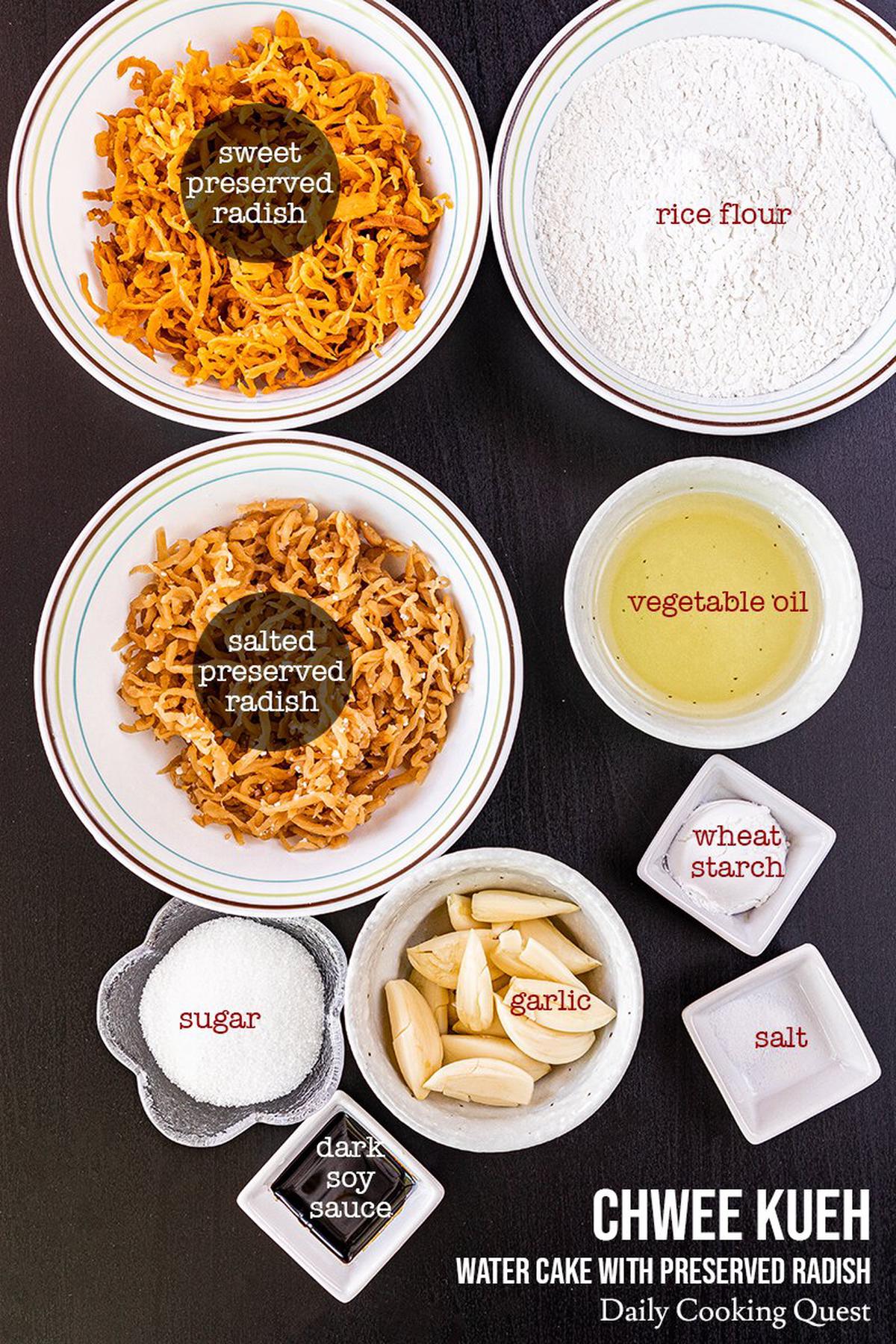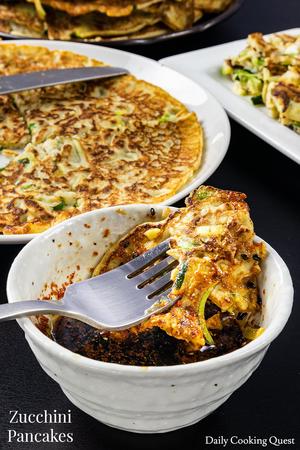Home / All Recipes / Chinese / Chwee Kueh - Water Cake With Preserved Radish
Chwee Kueh - Water Cake With Preserved Radish
How to cook chwee kueh (water cakes) at home with a steamer or a microwave. These cakes are delicious with the generous amount of preserved radish topping.
One of the joys of growing up in Indonesia is the array of snacks one can get from any wet market. I used to accompany my Mom on her weekly market shopping every Sunday morning, and as a treat, she would always stop by the snack stalls to buy some snacks home.
There are probably hundreds of items to choose from, and this chwee kueh (water cakes) served with preserved radish topping happens to be one of our favorite snacks, so we often have these when I was little. With this recipe, now I can make them anytime I want even when I live halfway across the globe from home. :)

What you need to make chwee kueh (water cake)
There are two parts to this snack, one is the chwee kueh (water cake) itself, and then there is the preserved radish topping. To make the cakes, you will need:
- rice flour
- wheat starch
- salt
- oil
- water
When you mix the batter, you will notice that the batter is super thin and watery, and that’s where the name of the cake comes from. Chwee kueh (水粿) literally translates to water cakes! They are tasteless, with a jiggly and slightly chewy texture, but tastes amazing when paired with the preserved radish topping.

What you need to make the cai po (preserved radish) topping
Next part of the chwee kueh equation is the delicious preserved radish topping. For this, you will need:
You can buy preserved radish from most Asian/Chinese markets. Both the sweet version and the salted version are usually just sitting side by side. Be sure to wash the preserved radish in plenty of water until the water is clear. Also, remember to dry them really well since we don’t want any splatter when frying them.

How to cook chwee kueh, using a steamer vs. using a microwave
Once you have finished preparing the chwee kueh batter, you have two options to cook the water cakes:
1. A steamer
Most Asian households have a big multi-tiered steamer in their kitchen, so steaming food is very common.
Traditionally, chwee kueh is steamed in individual tin cups, smaller in size compared to a standard-size muffin cup. A multi-tiered steamer can easily steam the whole batch in one go.
2. A microwave
I find that in the US, most household doesn’t own a steamer, instead, almost everyone has a microwave.
Luckily, you can cook chwee kueh in a microwave too, just be sure to use silicon baking cups or other vessels that are microwave friendly. You can use glass/ceramic ramekins.
And if you don’t mind non-circular shapes, feel free to use a rectangular baking glass and just cut them up into individual portions later with a knife. Just try cooking with 1-minute increment until the cake is set. :)

How to cook the cai po (preserved radish) topping
Preparing the topping is super easy. Once you have prep your preserved radish, what remains is a simple frying job. And here are my pointers to make delicious preserved radish topping:
- Since preserved radish can burn on high heat, be sure to use medium heat only. It should take about 15 minutes to properly fry them to fully develop the flavor.
- If during mid frying, you notice that the radish becomes dry, you can add 1-2 tablespoon of oil.
Also, I only use 1 tablespoon of dark soy sauce since I think this amount is enough. Some snack vendors that I frequent in the past can be stingy with the radish, instead, they increase the amount of dark soy sauce to compensate. If you have never sampled chwee kueh from more honest vendors, you will be pleasantly surprised with the generous amount of radish in this recipe. Enjoy!

Chwee Kueh - Water Cake With Preserved Radish
Ingredients
- Chwee kueh (water cake)
- 150 gram (0.33 lb) rice flour
- 1 tablespoon wheat starch
- 150 ml (10 tablespoon) cold water
- 1/8 teaspoon salt
- 5 tablespoon vegetable oil
- 500 ml (2 cup) hot water
- Cai po (preserved radish) topping
- 100 gram (0.22 lb.) sweet preserved radish
- 100 gram (0.22 lb.) salted preserved radish
- 4 tablespoon vegetable oil
- 1 whole bulb (~ 50 gram) garlic, minced
- 1 tablespoon dark soy sauce
- 2 tablespoon sugar
Instructions
- Chwee kueh (water cake)
- If using metal muffin pans, grease the pan. You can skip this if using silicon baking cups. (*)
- In a mixing bowl, stir/whisk together rice flour, wheat starch, and cold water. Then add salt and vegetable oil and mix well. Finally, add hot water and mix into a thin homogenous batter, then pour into muffin cups.
- Option 1 (using a steamer): Prepare a steamer over medium high heat, and once the water is boiling and steams are visible, steam the cakes for about 25-30 minutes, or until set.
- Option 2 (using a microwave): Cook for 1.5-2 minutes, or until the cake is set. Remember that you cannot use any metal in a microwave, so be sure to use silicon baking cups or glass/ceramic ramekins that are microwaveable if you choose to cook the cakes in a microwave.
- Remove the cakes from steamer/microwave and set aside to cool completely before removing the cakes from the cups.
- Cai po (preserved radish) topping
- Wash the preserved radish until water runs clear. Drain and then dry completely with a kitchen towel, and chop into tiny pieces.
- Heat the vegetable oil in a frying pan over medium heat, fry garlic and preserved radish until fragrant and the color turns darker. Be patient, since this should take about 15 minutes of gentle frying.
- Add dark soy sauce and sugar. Mix and cook until sugar has completely dissolved. Set aside.
- Serve the chwee kueh (water cake) with preserved radish topping.
Notes
- (*) The traditional chwee kue cups are made from tin and are smaller in size compared to a standard size muffin cup. If you want to use the traditional cups, you will need to adjust cooking time. Most likely, your steaming time will only be around 10 minutes instead of the 25-30 minutes.






Comments
Hai, i love chee kwee n whenever i am in singapore, i always buy it n tops it with lots n lots of chilli paste.. my question is, do u hv any idea of their chilli paste recipe, coz it goes really well with cheekue.. it does looks like the sambal goreng recipe you have,however u mention its for chilli base.. so i am not sure.. hahahaha...
Hi Christy, the one I grew up with is the Indonesian version, and the sellers usually don't include any sambal with chwee kueh. I tried to look for Singaporean chwee kueh, and yup, some seems to include sambal. From the photos, it looks like my sambal goreng recipe may actually work, or maybe even nasi lemak sambal. But since I have never actually tried the real deal myself, I can't be 100% certain which one is the closer chili sauce to use.
Hei thx for replying, i would try to make this soon n try out the either sambal, hopefully close enough... btw, your recipe blog is on point ♡ very helpful for my weekend cooking quest trying different recipes..
Thank you for the lovely comment. I'm glad my blog helps with your weekend cooking project. :)
This is such an interesting recipe. I love it. So easy and something different.
This sounds amazing. I love radishes but I haven't tried this yet. I am going to pick up the ingredients and give it a try. Thanks!
I always see this at the shops but I've never tried it before. Now I can and you've made it look so wonderfully easy! Thanks for sharing, Anita!
I tried this recipe they turned out amazing! Thanks so much for sharing it, and I can't wait to make it again!
I tried this recipe this morning - did not have wheat starch so I substituted with corn flour. Texture was just the right softness and taste. Thank you for sharing this... I’ll certainly be making more! Btw, I’ve tried it with sambal nasi lemak and it goes well with this.
Hi Anita, thanks for your chwee kueh recipe. Been searching for how to make it and yours looks like right. Will try it out. 👍
I'm from Singapore and I noted your comment about the sambal. I checked out your 2 mentioned sambal recipes. Both the sambals are not the correct ones for chwee kueh. They are too complicated (too many ingredients). Notwithstanding, the key "incorrect" ingredient is the kafir leave in the sambal goreng and the assam in the nasi lemak sambal. The really old time (ie long ago) traditional nasi lemak chilli made with only chilli and some very little onions can be used instead. The trick is to keep the chwee kueh sambal simple without distracting from the caipo. So the simplest way would just be to take some of your caipo mix and fry with dried red chilli (pounded or blended or etc). If you want more oomph, add some dried shrimp (also blended fine) or belahan - not too much. For flavouring only. Hope it helps.
Adding dried red chili and dried shrimp sounds like the perfect solution, Leslie. I'll be sure to give it a try next time I make chwee kueh.
Hello, this is the 4th time I try this recipe. All turned up well but the oil floats on top no matter how long I stir...lol...yes I know there is no emulsifying agent....is there way I can mix the oil into the flour then add water so it won't separate to 2 layers? Thank you.
Hi Karin, to prevent the separation, make sure that the steamer is ready before pouring the batter into muffin cups. Also, before pouring the batter, give it a stir so it becomes homogeneous again, then pour into muffin cups, and immediately into the steamer. Following these steps should troubleshoot the 2 layers problem.
Hi! I love chwee kueh but recently found out that I'm coeliac. Do you have a recommendation for replacing wheat starch to make this gluten free? Would tapioca starch work?
Hi Pri, you can use tapioca starch too. Please try using 1 tablespoon of tapioca starch to replace the 1 tablespoon of wheat starch.
Leave a comment